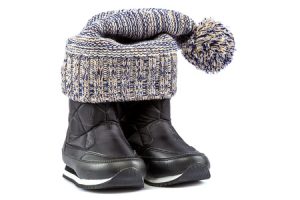As a horse owner, you probably want to spend as much time as you can with your horse. Feeding, grooming and of course riding are all activities that you truly enjoy. And the more time that you’re able to be outside with your horse the better, right? This is probably true all year long…except when winter arrives with cold wind, freezing temperatures, heavy snow, and slippery ice. Even those every day simple barn chores can become increasingly challenging as the temperatures start to drop. You find yourself struggling with frozen water pipes and slippery walkways, and while your fingers and toes are getting colder and colder, you keep thinking there must be an easier way to deal with this mess! Fortunately, with a little preparation and by taking some extra precautions you can make winter barn chores easier. So here are a few time saving tips that can help you deal with the cold, wet winter weather.
What To Wear
Before you head outside to feed your horses, cleans stalls and start your general barn chores, one of the first things you’ll need to do to help make winter barn chores easier is to wear the appropriate clothing. While it might be tempting to bundle up in as much outer gear as you can possibly find, you’re going to need to remain mobile and flexible as you venture outside to work. Layering is the key to success especially since once you start cleaning water buckets and mucking stalls, you’ll start to warm up and soon you’ll be able to take off the layers as you move around. Start with a base layer of long underwear or leggings made of a material that is designed to keep moisture away from your skin (known as wicking). Base layers that are made out of silk or merino wool are excellent choices and come in a variety of weights suitable for different temperature ranges. For outerwear, down-insulated and lined canvas vests or jackets are perfect since they can offer protection against cold weather without restricting movement. Add a pair of insulated boots and thermal socks, and then top it off with a warm hat or fleece headband plus some cozy earmuffs if needed. You’re also going to need to carry a few different types of gloves, depending on the types of chores that you’re doing at the time. Fleece-lined leather gloves are great for warmth and protection, but you probably will need a lighter style glove that is made of an insulated and waterproof material for those chores that require dexterity.
Stall Cleaning Made Easy
One way to make winter barn chores easier is to use the proper tools and establish a regular routine when you’re cleaning stalls. If you use straw for bedding, you’ll want to use a pitchfork and if you use shavings or wood pellets then you’ll need a bedding fork with tines that are close together. The type of bedding that you use in your stalls will play a big role in how fast you can clean the stalls. Shavings and wood pellets typically are easier to sift through, while straw can be more difficult to work with since manure often gets mixed in with the straw and is harder to separate and clean. When you’re ready to clean the stalls, gather your tools and your wheelbarrow or muck bucket and bring them all with you to the stall that you’re going to clean. Begin by moving the clean bedding against the back walls and corners of the stall, separating the clean bedding from the wet, soiled bedding. As you’re sifting through the material, keep moving any manure and soiled areas into a single pile in the middle of the stall. Finally, remove the wet bedding and manure from the center of the stall (put it in your wheelbarrow or muck bucket), sweep up any remaining wet spots, and let the stall air out and dry as much as possible. You can then sprinkle the stall floor with an absorbent deodorizer and finally spread the clean bedding back throughout the stall, adding fresh new bedding on top as needed. You can also try bedding the stall with a thicker layer of shavings which will help keep the stall dry, plus there will be less ammonia odor in the stall. If you follow this routine, you won’t have to strip your stall as often plus you’ll save money since you aren’t unnecessarily throwing away clean bedding. Another idea is to line the stall floors with rubber mats underneath the shavings or straw, which will also help with drainage and will protect the floors from wear and tear (less repair work for you in the long run).
Winter Water Challenges
During the wintertime, trying to deal with your horse’s water buckets, garden hoses, water pipes and outdoor plumbing fixtures are some of the biggest challenges that horse owners are faced with.
Water buckets and troughs can quickly freeze over when the temperatures drop, so you’ll want to check your horse’s water several times during the day to see that it’s not frozen. You’ll be able to save time and make winter barn chores easier by using heated water buckets or insulated buckets that will help prevent your horse’s drinking water from turning into ice. Heated buckets will require electricity, so this may or may not be an option for you depending on how your barn is set up. If you’re not able to use heated or insulated buckets, there are handy tools that are made specifically for dealing with ice. You can use these tools to easily break up and also remove ice from the water buckets – all without getting your hands wet! Of course, you’ll still need to regularly clean out the water buckets, troughs or auto-waterers and also keep any electrical cords in a location where your horse cannot reach them. Most horses will drink between 8 – 12 gallons of water a day and typically prefer water temperatures around 45-65 degrees Fahrenheit, so you’ll want to do everything you can to keep your horse properly hydrated in the winter.
Along the same lines, water hoses can also be challenging during the winter especially if the hose fittings are leaking and patches of ice form on walkways or in the barn isles. You can save a lot of time and hassle if you repair or replace any leaking hose fittings before they become bigger problems. Another issue that you may encounter is your garden hose may freeze when the temperatures drop, and you won’t be able to use your hose until the ice inside melts. You can try to prevent this by thoroughly draining the hose after each use so residual water is not left inside to freeze. Or if you have electricity nearby, you can try using a heated hose which can be a convenient and reliable way to provide a constant source of water in freezing temperatures. Another option is to use insulation on your garden hoses and fixtures. Insulation usually will help keep your hoses and fixtures from freezing in the winter, but you will still need to check them from time to time to make sure the insulation is working properly.
Another issue you might have to deal with during the winter are frozen pipes. You can help prevent your pipes from freezing by insulating them before the temperatures drop – it takes a little preparation in advance, but it is definitely well worth the extra effort in the long run. Also, make it a regular habit to fill up extra jugs and barrels with water and keep them in a spare room or location where they’re not exposed to the winter elements. That way if you are faced with frozen pipes, you’ll be well prepared with an extra water supply for you and your horses.
Organize Your Barn
How much time do you spend each day walking around looking for that misplaced shovel, rake or brush? Having your barn well organized with the proper tools that are in good working condition will help make winter barn chores easier. If you’re pushing around an old wheelbarrow that has holes in the bottom and is dropping shavings and manure as you’re trying to clean the stalls, you’re probably spending more time picking up after yourself than you are actually getting the chores done! So you can either repair the holes in your wheelbarrow or invest in a new one. Also, by keeping the wheelbarrow tires filled with air, you’ll find that it’s a lot easier to move around especially on slippery areas. Another helpful tip is if you’re using a plastic pitchfork, you might want to replace it with a metal one which is less likely to break when picking up frozen manure. So take some time and either repair or replace any faulty or inefficient barn equipment – you’ll be glad that you did especially during the winter.
Next, go through your feed and tack rooms and spend a day organizing the shelves and storage areas. If you have a pile of halters and lead lines stashed in the corner of your tack room, take them out and hang a halter and lead line on each horse stall – this will save you a lot of time since you won’t have to walk back and forth every time you need to take your horse out of his stall (this is especially important in case of an emergency). Bathroom organizers come in a variety of sizes and are great for storing your grooming supplies, towels, sponges, etc. Plastic storage containers are also convenient for stashing away blankets and extra tack, plus they are easily stacked which will help keep your tack room neat and organized. If you want, you can select a different color container for each horse, and label them with permanent markers so you’re not wasting time looking for that special halter or extra piece of tack.
When it comes to medication, we’ve all experienced trying to use a topical wound salve only to find that it’s thickened from the cold (or even worse, frozen solid). Plus cold temperatures and moisture from rain and snow can affect many prescribed medications. So check the storage recommendations on all of the labels and keep the medications and salves in a location that is temperature controlled.
For your outdoor gear, keep all of your outdoor tools together in one place where they’re easy to locate – this would include snow shovels, salt or cat litter for the walkways, and also flashlights or battery-powered headlamps which will allow you to use your hands freely as you go through your daily barn chores. In cold weather, your metal handled tools can be hard to grip (plus they are cold!) so try wrapping the handles with tennis grip tape or bandaging wrap such as Vetrap.
If your budget allows for it, you could save a lot of time by investing in a good, quality leaf blower and a heavy duty shop vacuum. A leaf blower is a great way to easily clean gutters and walkways, while a shop vac can save you time by using it to clean inside your barn instead of sweeping with a broom.
Hay and Supplements
If you have enough storage room, stock up on your winter hay supply while the prices are still low. You’ll want to look for green, fresh smelling hay that you can feed to your horse throughout the winter. Keep a bale-opening tool nearby so that you’re not wasting time wrestling with the baling twine or searching for something that you can use to open the hay bales.
You can speed up your feeding time by putting all of your horse’s feed and supplements into a large utility cart – that way you can go down the aisle and stop at each stall instead of running back and forth every time you remember something else you need to give to your horse. You can make feeding time even more efficient by adding small swing-out windows or openings over the feed bins; that way you won’t have to open and close each stall door every time you feed.
You can also prepare your horse’s meals ahead of time in ziplock baggies, which will reduce the amount of time that you spend scooping and measuring the feed. Each baggie can hold your horse’s senior feed, concentrates and supplements (such as InflamAway HA-200 Joint Supplement and Hoof ReNu Hoof Supplement) – just label each baggie with the horse’s name and you can easily wheel the hay and supplements down the barn aisle as you feed each horse. Also, while you’re preparing your horse’s breakfast, you can also make up his evening meal at the same time and store it in a separate container. That way, your evening feeding chore is as simple as emptying his pre-measured meal into his bucket.
Grooming/Horse Care
Another way you can make winter barn chores easier is to hang your horse blankets on the outside of the stalls. Instead of wasting time rummaging through piles of blankets to find the right size or weight blanket for your horse, you can get blanket bars to hang on each stall door. You can then place the right blanket outside of each horse stall and it’ll be ready to use when you need it. Of course, check that your blankets are cleaned and repaired before the cold winter weather sets in.
Grooming your horse in the winter can also be challenging, so keep your grooming supplies in a location where they’re not exposed to the cold winter elements and could possibly freeze. If you want to do quick grooming sessions with your horse, you can put all of your grooming supplies in your utility cart and bring the grooming tools over to your horse which will also save time. For quick touch ups in the winter, you can try a waterless bath product like Miracle Groom which will help clean your horse without water. You can also use a crock pot to keep towels and water warm for grooming – warm towels are also great for stain removal, plus your horse will surely enjoy the extra pampering. Crock pots for the barn can be very useful, but you’ll want to make sure that it is not left unattended and your electrical system needs to be up to date.
So even if you enjoy the beauty and recreation that the winter season brings, you probably agree that barn chores during the winter time can sometimes be challenging and we’re all looking for ways to make the winter chores a little easier. If you have additional time saving tips that help you with your barn chores, let us know – we’d like to hear your ideas.











Leave a Reply